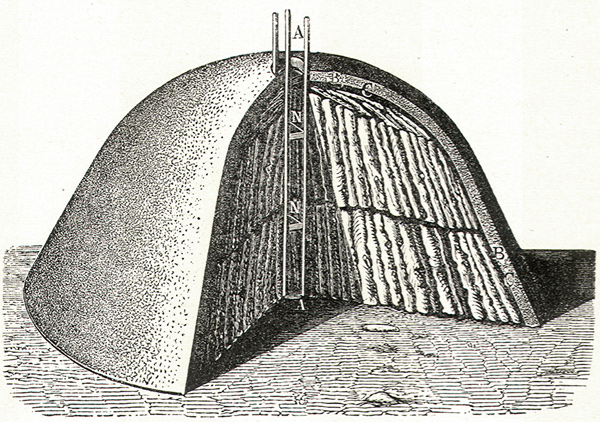At Fort Mandan below the Knife River Villages, several enlisted men attempt to melt the Missouri River ice surrounding boats resulting in exploding rocks. Others keep the charcoal pile burning.
Charcoal Pile
Manuel de la Métallurgie du Fer, Tome 1, by Adolf Ledebur (Librairie polytechnique Baudry et Cie, 1895), 69.
The expedition journalists called theirs both a kiln and a pit, but they likely made a charcoal pile similar to the one shown in the figure above. Charcoal piles are typically covered by turf as described by Ordway on 27 January 1805. Charcoal kilns are more permanent structures made from stone. The short time-frame frame at Fort Mandan as well as the frozen ground may have made building a kiln and or pit unlikely.[1]Eric Sloane, A Reverence for Wood (Mineola, New York: Dover Publications, 1965), 57–60; Alex W. Bealer, The Art Of Blacksmithing (New York: Castle Books, 1995), 33–35.
Exploding Rocks
We attemped another plan for getting our water craft disengaged from the ice: which was to heat water in the boats, with hot stones; but in this project we failed, as the stones we found would not stand the fire, but broke to pieces.
—Patrick Gass
Making Charcoal
we are now burning a large Coal pit, to mend the indians hatchets, & make them war axes, the only means by which we precure Corn from them—
—William Clark
Weather Diary
Ther. at rise
Weather Wind at rise
Thert. at 4 P.M. Weather Wind at 4 P.M. River 4 [above 0] fair S W 16 [above 0] fair W raise ½ in. —Meriwether Lewis[2]To assist the reader, the editor of this web page has omitted the date column, merged the “River” columns, and spelled out some abbreviations.
Experience the Lewis and Clark Trail
The Lewis and Clark Trail Experience—our sister site at lewisandclark.travel—connects the world to people and places on the Lewis and Clark Trail.
Plan a trip related to January 29, 1805:

Fort Mandan is a High Potential Historic Site along the Lewis and Clark National Historic Trail managed by the U.S. National Park Service. The North Dakota Department of Parks and Recreation manages a modern reconstruction and the Lewis and Clark Interpretive Center located at US Hwy 83 and ND Hwy 200A.
Knife River Indian Villages National Historic Site is a High Potential Historic Site along the Lewis and Clark National Historic Trail managed by the U.S. National Park Service. A unit of the National Park System, the site is located at 564 County Road 37, one-half mile north of Stanton, North Dakota. It has exhibits, trails, and a visitor center.
Notes
| ↑1 | Eric Sloane, A Reverence for Wood (Mineola, New York: Dover Publications, 1965), 57–60; Alex W. Bealer, The Art Of Blacksmithing (New York: Castle Books, 1995), 33–35. |
|---|---|
| ↑2 | To assist the reader, the editor of this web page has omitted the date column, merged the “River” columns, and spelled out some abbreviations. |



